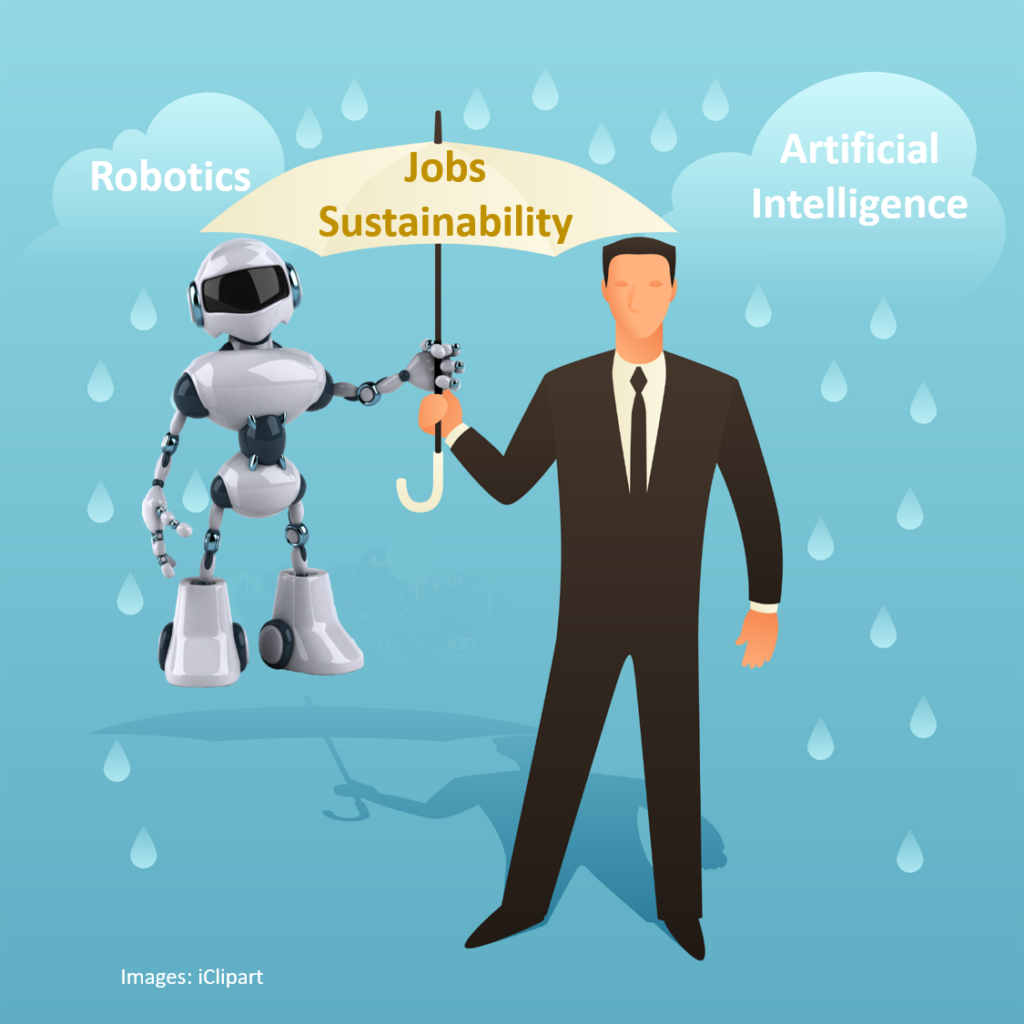No one really knows what the future holds. Some pundits see dark clouds on the horizon filled with the thunder of artificial intelligence (AI) and the lightning of robotics. They predict a great storm is coming — a deluge that will wipe out human employment in the decades ahead. Other pundits see those same clouds and hear those same rumblings but assert the storm will be more like a spring shower that fosters new growth and prosperity. One thing both groups have in common is the belief that the work environment is going to change in dramatic ways. The good news is that the optimists appear to be gathering an increasing number of supporters to their point of view. As a result, there are more discussions about how humans and machines can collaborate in the future workplace. Joe Atikian (@joe_atikian), author of Industrial Shift: The Structure of the New World Economy, predicts, “The robots are not coming for our jobs.”[1] He has to admit, however, his prediction is not entirely accurate. He explains, “Advances in technology don’t guarantee that everyone will come out okay. When manufacturing work declines, current workers don’t easily move into IT jobs. While half of displaced workers find new work at equal or higher pay, perhaps in the new robotics field, a few will move into other kinds of work at lower pay, and then lose their jobs altogether.” His warning is a reminder that jobs sustainability in the Cognitive Computing Era is a serious topic needing to be addressed.
Jobs Sustainability Now and in the Future
With unemployment at near historical lows in the U.S., and with job openings in the millions, worrying about jobs sustainability may seem unwarranted. Here’s the rub. The skills gap that has resulted in the large number of unfilled jobs will hasten the onset of more automation and could result in a human versus machine future. To ensure a bright jobs front future, we need to ensure humans work with machines rather than race against them in the decades ahead. Fortunately, McKinsey analysts, Michael Chui (@mchui), Katy George, James Manyika, and Mehdi Miremadi, predict human/machine collaboration will characterize the future workplace. They write, “Today, we are on the cusp of a new automation era: rapid advances in robotics, artificial intelligence, and machine learning are enabling machines to match or outperform humans in a range of work activities, including ones requiring cognitive capabilities. … New technologies are opening a new era in automation for manufacturers, one in which humans and machines will increasingly work side by side.”[2]
Humans may end up working side-by-side with machines, but the future work environment is likely to be very different than today’s environment. Brennan Hoban (@brennanhoban), Brookings’ Communication Coordinator, writes, “As innovations in artificial intelligence, robotics, and other technology bring us virtual assistants, wearable health tech, autonomous vehicles, and more, many industries are transforming rapidly. While these new technologies have brought unimaginable benefits, they also are disrupting many industries and changing the structure of the workforce.”[3] Randy Swearer (@randyswearer), a Vice President at Autodesk, suggests five things employers can do to prepare their workforce for tomorrow’s workplace.[4] They are:
1. Find ways to build trust between human and machine teammates. Swearer writes, “Trust is a key component of any good collaboration, but in order to build trust between humans and machines, companies will have to create policies and invest in systems that encourage co-creation and co-learning. If tools, products, spaces, and experiences have machine intelligence embedded in them, we should look for ways to build virtuous and ethical cycles of learning between the company, the things it produces, and the people who use them.”
2. Train people how to ask questions and frame problems. Three professors from the University of Toronto’s Rotman School of Management, Ajay Agrawal, Joshua Gans (@joshgans), and Avi Goldfarb (@avicgoldfarb), make a profound observation about the value of technology. “Technological revolutions,” they write, “tend to involve some important activity becoming cheap.”[5] Kevin Kelly (@kevin2kelly), founding Executive Editor of Wired magazine, insists artificial intelligence has made getting answers cheap. He writes, “While answers become cheap, our questions become valuable.”[6] That’s why Swearer insists, “Working with machine intelligence requires skilled problem framing, not just problem solving. Problem framing relies on systems thinking to understand the dynamic, interdependent nature of problems.”
3. Practice building and mining possibility spaces. Because cognitive systems can integrate and analyze massive amounts of data from numerous sources, they are ideal platforms for generating cross-discipline solutions — what Swearer calls the “possibility spaces.” Swearer writes, “Tools fueled by machine intelligence often require us to think very differently about solving design problems. Instead of thinking about the tool as a blunt instrument to realize our preconceived design intentions, we first need to frame the system constraints, variables, goals, and intersection points. Then the system co-creates with us a ‘solution space’ of design possibilities to choose from and iterate.”
4. Establish an intern program that leverages the power of machine and human learners. A number of pundits recommend preparing the future workforce by implementing intern and/or apprenticeship programs. Swearer writes, “Given the extreme pace of change today, finding seasoned engineering, business, or design professionals with more than a decade of experience co-creating with machine intelligence is very challenging. What businesses can do, however, is hire interns from machine learning academic programs and offer them opportunities to work with their data.”
5. Share stories that highlight opportunities for co-creating with machines. Storytelling has proven its power to motivate throughout the course of history. Swearer recommends harnessing that power to motivate employees to embrace the human/machine work environment. He writes, “Share stories from others and generate your own that highlight the opportunities for co-creating with machines. This watershed moment demands that organizations invest in storytelling to bridge the current way things are done and the new emergent paths ahead.”
Atikian believes the greatest impact of AI and robotics will be felt by the next generation. He notes, “Virtually no kids or young adults want to work in a factory or even know what a factory is. They don’t tend to make or fix things with their hands, much as a 1960s factory worker deliberately knew nothing about growing wheat. Instead, today’s youngsters are computer coders. They want to write apps for smartphones and dream of making a fortune in a startup.” On the positive side, younger generations demonstrate less fear about AI than older generations. When Darrell M. West (@darrwest), vice president of Governance Studies and director of the Center for Technology Innovation at the Brookings Institution, polled 1,535 adult Internet users, he found, “Older people were slightly less positive about AI than young adults.”[5]
Summary
Cognitive machines are going to be a part of future regardless of how we may feel about them. To ensure we work with rather than race against such machines, we need to begin laying the groundwork for tomorrow’s collaborative environment today. Former IBM executive Irving Wladawsky-Berger insists, “It can take decades for new technologies and business models to be widely embraced by companies and industries.”[8] Laying the groundwork for human/machine collaboration is our best hope for ensuring the clouds on the horizon nourish rather than destroy the work environment.
Footnotes
[1] Joe Atikian, “Robots, AI, and jobs: All three are coming,” The Globe and Mail, 13 May 2018.
[2] Michael Chui, Katy George, James Manyika, and Mehdi Miremadi, “Human + machine: A new era of automation in manufacturing,” McKinsey & Company, September 2017.
[3] Brennan Hoban, “Artificial intelligence will disrupt the future of work. Are we ready?” The Brookings Institution, 23 May 201.
[4] Randy Swearer, “Learning to Embrace Intelligent Machines in the New World of Work,” IndustryWeek, 24 May 2018.
[5] Ajay Agrawal, Joshua Gans, and Avi Goldfarb, “The Simple Economics of Machine Intelligence,” Harvard Business Review, 17 November 2016.
[6] Kevin Kelly, “With AI, Answers Are Cheap, But Questions Are The Future,” Longitudes, 9 March 2017.
[7] Darrell M. West, “Brookings survey finds worries over AI impact on jobs and personal privacy, concern U.S. will fall behind China,” The Brookings Institution, 21 May 2018.
[8] Irving Wladawsky-Berger, “Human-Machine Work Teams: The Promise and Today’s Reality,” The Wall Street Journal, 25 may 2018.





